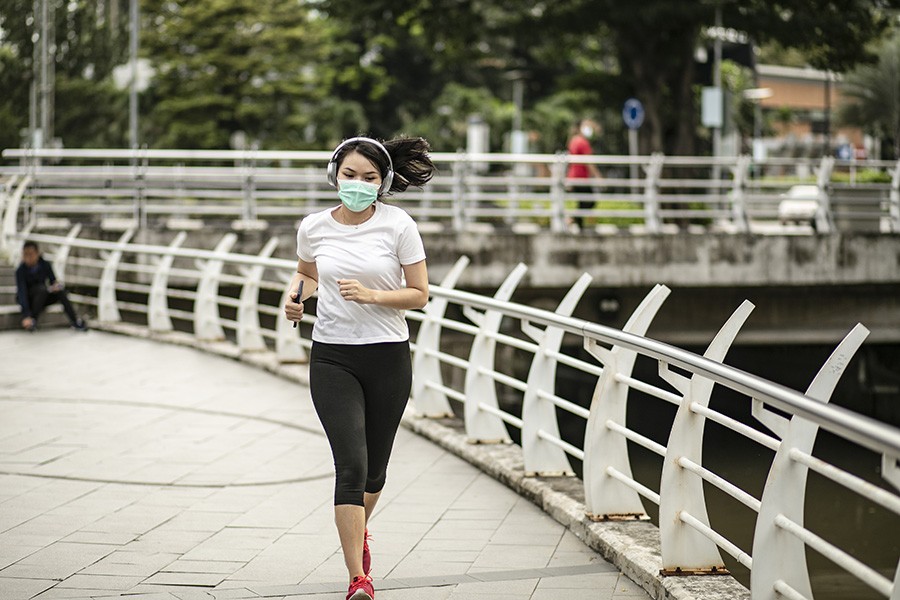Here’s Some Advice on Wearing a Face Mask While Running
Anyone without a face mask on in a place where social distancing is not possible can now be fined up to $300 in Boston—including runners.

Photo via Getty Images
When we first started quarantining here in Boston, I made a promise to myself that, as a way to maintain my mental and physical health, I would run or walk around the Jamaica Plain pond every day, no matter what. I figured that if I could muster the strength to walk to work every day during pre-pandemic life, this was the least I could do to get out of the monotony of being in my home 24/7.
It worked for the first month. Now, heading into the third, my body is tired and I have a nagging pain in my left leg that I’m praying is not a stress fracture. And the one thing I used to rely on to make my life feel a little more “normal” doesn’t feel so normal anymore. As I strap on my homemade face mask and head out into a neighborhood of people who are also masked, the only piece of human interaction I’m managing is locking eyes with passersby, and I’m anxiously reminded that this is indeed not normal life.
But my runs haven’t stopped. I’ve just had to adapt and adjust to what my body, and the government, is telling me. After Somerville announced fines for anyone not wearing a face mask on April 27, Governor Charlie Baker followed suit for the rest of the state on May 1, enacting a mandatory face mask mandate for everyone in the Commonwealth. What was once a strong suggestion could now cost you $300 if you’re caught without a face covering. According to the Centers for Disease Control and Prevention, and previous Boston reporting, face masks should follow these guidelines:
- fit snugly but comfortably against the side of the face
- be secured with ties or ear loops
- include multiple layers of fabric
- allow for breathing without restriction
- be able to be laundered and machine dried without damage or change to shape
So, it could just be a bandana or an old t-shirt, but your nose and mouth should be covered any time you’re outside your home and can’t maintain six feet from your neighbor. Yes, that means while you’re exercising and running outdoors. You may feel just like me, though, and wonder how the heck you’ll breathe, or feel any type of stress relief when you have a constant reminder on your face of the very real stressors surrounding us everyday.
Cara Gilman, a running and yoga coach in Boston, says she’s still trying to figure out how to be comfortable in a mask while exercising, but she has found Buffs to be the best so far. Buffs are multi-use headwear. They can be used around the neck as a neck warmer or as a headband. They’re a little more light-weight since they’re meant to be worn while exercising, and can be repurposed as a mask since they cover the nose and mouth. Local running store Janji also sells something similar. Marathon Sports is also coming out with a running-specific face mask. “You just want to find something a little more breathable,” Gilman says. “I’ll wear the Buff around my neck and chin when I’m nowhere near people and pull it up if I get within six feet of someone.” If you’re pulling from something from your wardrobe, like an old t-shirt or bandana/scarf, go for something that is cotton or polyester, since both are thin and breathable. Bonus points for polyester, since it’s known to be sweat wicking.
For someone who lives on the North Shore, this is a little more easily maintained than for runners in the city taking to crowded places like the Esplanade or even my beloved JP pond. Gilman says part of the added stress we’re feeling is that we want to go back to our old running habits. “We feel trapped by the mask and stressed that everything feels so different. Now we can’t even go for a run in the same way, and it’s a stress response the same way as when we put the news on.”
So what’s a runner to do? Gilman says this is a great opportunity to revisit why you like running in the first place, as many Boston Marathon runners had to do when the race was postponed.
“Runners tend to be Type A people,” Gilman tells me. “We’re expecting what we expected before. We hold a pace and a time, but we have to be able to change things up moment by moment and day by day. We have to do that in our running practice.” Whether that means crossing the road when you’re about to pass someone on the sidewalk, or taking a completely new route, or strapping on that face mask before you leave the house, there just has to be a little more acceptance of what is, rather than mourning what you’ve lost or resisting the current, strange status quo.
If you still feel overwhelmed by anxiety while trying to jog with a mask on, Gilman says to stop and breathe. “There’s a yoga breath called ujjayi breath where you breath in through your nose and exhale through your nose,” she says. “It’s a little more constricting, so only practice it while wearing a mask if you feel comfortable, but it’s a good way to relax your system.”
For others, she says to simply stop or switch to walking if your breathing starts to feel too constricted, and place your hand on your belly and focus on breathing deeply and slowly: “You should envision your stomach as a balloon that’s inflating.” Another good breath practice to calm yourself down, she says, is to do a couple rounds of inhaling deeply while shrugging your shoulders and then exhaling forcefully while shooting your hands and arms toward the ground envisioning all of your worries leaving your body.
If you do start to notice your breathing become frantic and short in a way it doesn’t usually, stop immediately, get away from other people, and take the mask off until you feel your breathing return to normal.
The coronavirus pandemic may be putting a full stop to things we once used to do—like drinking beer at a bar, exercising in a gym with other people, and going to the library—but it doesn’t mean that there aren’t different ways of creatively doing those things. Running while wearing a mask is just another adjustment to make, and the fastest way to feel okay about the situation is to adapt, accept, and move on, one foot in front of the other.


